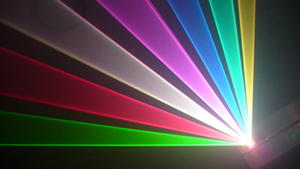I have been working on testing a large number of diodes to determine if A140 really is better than A130, and in general characterize these projectors.
Test Setup:
Mechanical
The test setup consists of TEC cooler, upon which complete XJ-A130/A140 arrays are mounted to. The internal thermistor is used for temperature feedback, and the stock lenses are used for collimation. The temperature is kept at 25.0C, +/-1C, over the entire array.
A typical IV plot is shown below:
Power (electrical)
The diodes are powered by a HP6633a power supply, in constant current mode, in a stairstep current sweep from 0.001 to 1.500A. Each current is kept for 0.5s, to allow the diode to come into thermal equilibrium with the mounting block and allow the power meter to settle. For reference, it was found that decreasing the pulse length to 0.1s changed the power reading less than 5%.
Power (optical)
A Coherent FieldMaster GS and LM-2 probe w/1000x attenuator is used to measure the power. The calibration on the meter is out of date and I suspect it may be as much as 10% off comparing to other meters, but for relative measurements I have found it is very repeatable (retesting an array over a period of several weeks gave results within 1% of each other). A simple robot is used to move the power meter to each of the diodes in the array, such that large number of diodes can be tested 'easily'
Wavelength
A piece of optical fiber was mounted in the LM-2 power meter probe, such that some of the back power is sent to an Ocean Optics USB650 (aka, Red Tide) grating based spectrometer. Due to the fact that some of these diodes have very broad spectra (some over 2nm wide) I do a Gaussian fit to the data, and take the center value. This seems to be fairly reliable, however I have not had a chance to do a rigorous calibration of the system, so I would only trust the wavelength readings to +/-5nm absolute and +-2nm relative to each other. The std dev of the fit is checked, and it below 1.1 the data point is ignored in the plots.
Findings - A130 vs A140
These plots were generated in late 2010 with 96 A140 diodes, and 1656 A130 diodes (thanks guys!), so while the A140 sample size is a little on the small size I believe I have enough information to draw statistically significant conclusions.
A130 vs A140
Below find a histogram of the A130 vs A140 power distribution.
For the skeptics, here are some numbers:
So-Code:A130 A140 Mean 1.09 1.03 Std Dev 0.16 0.08
The A130 diodes are more spread out than the 140 diodes, that is to say that there are many more bad diodes (approximately 3% of the A130 diodes put out less than 0.5w, where as I have yet to see a single dud diode from an A140), however I have also seen a much higher percentage of the <1.2w output diodes form A130s.
Findings - Wavelength
I was able to test 888 A130 and 360 A140 diodes for wavelength, and have attached a histogram of the results below:
As you can see, the wavelength spread is quite broad, with significant numbers of diodes from 435 to 455nm. Furthermore, on average the A140 diodes have a shorter wavelength than the A130 diodes, which is quite unexpected (one would expect that the A140 would use longer wavelength diodes, because longer wavelengths have a higher luminosity)
Additionally, I plotted the wavelength vs power for each of the diodes to generate the following scatter plot:
From this you can see that there is almost no correlation between wavelength and power, however you can also see that the corner we are after (high wavelength, high power) is pretty sparse. Again, this shows that while the A140 did have a slightly higher power on average, it has a significantly lower average wavelength.




 Reply With Quote
Reply With Quote


